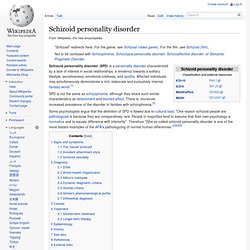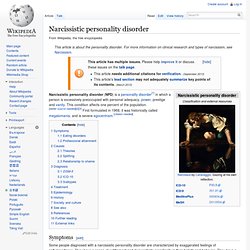

Personality Disorders. Psych Central - Personality Patterns. Based upon the International Personality Item Pool (IPIP) Everybody is curious about their personality, so psychology to the rescue!

Our personality test is similar to the Myers Briggs (MBTI) and the Jung personality tests, and is based upon an open-source set of personality testing items. These items are based upon scientific research and will provide results typical of a five-factor model of personality. The five factors measured by this test are extraversion, agreeableness, conscientiousness, emotional stability, and intellect/imagination. Please remember that these are only personality traits or preferences -- they do not predetermine every action you prefer in every situation. This test consists of just 50 questions and takes about 7 minutes for most people to complete. First, let's get started with some basic demographic information about you... Reference: Goldberg, L. Personality Disorders AllPsych Online. Section 1: Changing Personality Section 2: Personality Disorders Section 3: Application of Theory to Practice Section 4: Personality Trends Maladaptive Patterns of Interacting Personality Disorders are characterized by an enduring pattern of thinking, feeling, and behaving which is significantly different from the person's culture and results in negative consequences.

Cluster A. WHO Bluebook.pdf (application/pdf Object)
Avoidant. Histrionic personality disorder. Antisocial personality disorder. Antisocial (or dissocial) personality disorder is characterized by a pervasive pattern of disregard for, or violation of, the rights of others.

There may be an impoverished moral sense or conscience and a history of crime, legal problems, impulsive and aggressive behavior. Antisocial personality disorder (ASPD) is the name of the disorder as defined in the Diagnostic and Statistical Manual (DSM). Dissocial personality disorder is the name of a similar or equivalent concept defined in the International Statistical Classification of Diseases and Related Health Problems (ICD), where it states that the diagnosis includes antisocial personality disorder.
Both manuals have similar but not identical criteria.[1] Both have also stated that their diagnoses have been referred to, or include what is referred to, as psychopathy or sociopathy, though distinctions are sometimes made.[2][3][4][5][6] Diagnosis[edit] DSM-IV-TR[edit] B) The individual is at least age 18 years. ICD-10[edit] Schizotypal personality disorder. Schizotypal personality disorder is a personality disorder characterized by a need for social isolation, anxiety in social situations, odd behavior and thinking, and often unconventional beliefs.

People with this disorder feel extreme discomfort with maintaining close relationships with people, and therefore they often do not. People who have this disorder may display peculiar manners of talking and dressing and often have difficulty in forming relationships. In some cases, they may react oddly in conversations, not respond or talk to themselves.[1] They frequently misinterpret situations as being strange or having unusual meaning for them; paranormal and superstitious beliefs are not uncommon. People with this disorder seek medical attention for things such as anxiety, depression, or other symptoms.
Schizoid personality disorder. SPD is not the same as schizophrenia, although they share such similar characteristics as detachment and blunted affect.

There is, moreover, increased prevalence of the disorder in families with schizophrenia.[2] Some psychologists argue that the definition of SPD is flawed due to cultural bias: "One reason schizoid people are pathologized is because they are comparatively rare. People in majorities tend to assume that their own psychology is normative and to equate difference with inferiority". Therefore "[t]he so-called schizoid personality disorder is one of the more blatant examples of the APA’s pathologizing of normal human differences.
Dependent personality disorder. Dependent personality disorder (DPD), formerly known as asthenic personality disorder, is a personality disorder that is characterized by a pervasive psychological dependence on other people.

This personality disorder is a long-term (chronic) condition in which people depend on others to meet their emotional and physical needs, with only a minority achieving normal levels of independence. The difference between a 'dependent personality' and a 'dependent personality disorder' is somewhat subjective, which makes diagnosis sensitive to cultural influences such as gender role expectations. Narcissistic personality disorder. Symptoms[edit] Some people diagnosed with a narcissistic personality disorder are characterized by exaggerated feelings of self-importance.

They have a sense of entitlement and demonstrate grandiosity in their beliefs and behavior. They have a strong need for admiration, but lack feelings of empathy.[4] Symptoms of this disorder, as defined by the DSM-IV-TR, include:[1] Expects to be recognized as superior and special, without superior accomplishmentsExpects constant attention, admiration and positive reinforcement from othersEnvies others and believes others envy him/herIs preoccupied with thoughts and fantasies of great success, enormous attractiveness, power, intelligenceLacks the ability to empathize with the feelings or desires of othersIs arrogant in attitudes and behaviorHas expectations of special treatment that are unrealistic Another narcissist symptom is a lack of empathy.
Paranoid personality disorder. Paranoid personality disorder (PPD) is a mental disorder characterized by paranoia and a pervasive, long-standing suspiciousness and generalized mistrust of others.

Individuals with this personality disorder may be hypersensitive, easily feel slighted, and habitually relate to the world by vigilant scanning of the environment for clues or suggestions that may validate their fears or biases. Paranoid individuals are eager observers. They think they are in danger and look for signs and threats of that danger, potentially not appreciating other evidence.[1] They tend to be guarded and suspicious and have quite constricted emotional lives. Causes[edit]